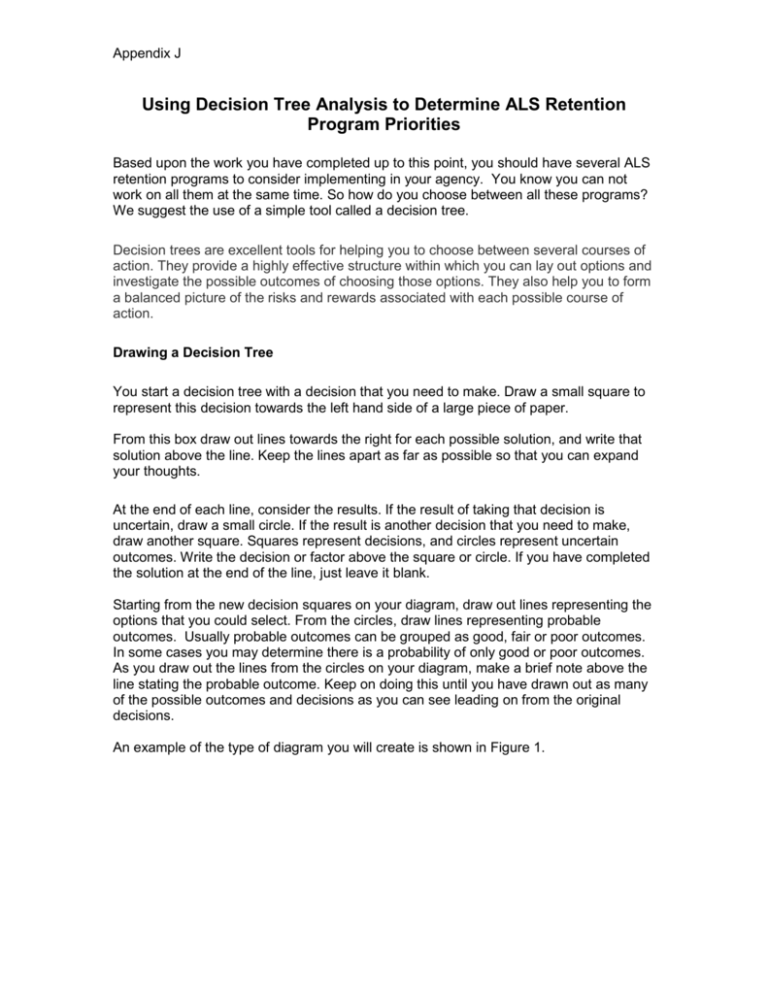Appendix J - Using Decision Tree to Determine Retention Program
advertisement

Appendix J Using Decision Tree Analysis to Determine ALS Retention Program Priorities Based upon the work you have completed up to this point, you should have several ALS retention programs to consider implementing in your agency. You know you can not work on all them at the same time. So how do you choose between all these programs? We suggest the use of a simple tool called a decision tree. Decision trees are excellent tools for helping you to choose between several courses of action. They provide a highly effective structure within which you can lay out options and investigate the possible outcomes of choosing those options. They also help you to form a balanced picture of the risks and rewards associated with each possible course of action. Drawing a Decision Tree You start a decision tree with a decision that you need to make. Draw a small square to represent this decision towards the left hand side of a large piece of paper. From this box draw out lines towards the right for each possible solution, and write that solution above the line. Keep the lines apart as far as possible so that you can expand your thoughts. At the end of each line, consider the results. If the result of taking that decision is uncertain, draw a small circle. If the result is another decision that you need to make, draw another square. Squares represent decisions, and circles represent uncertain outcomes. Write the decision or factor above the square or circle. If you have completed the solution at the end of the line, just leave it blank. Starting from the new decision squares on your diagram, draw out lines representing the options that you could select. From the circles, draw lines representing probable outcomes. Usually probable outcomes can be grouped as good, fair or poor outcomes. In some cases you may determine there is a probability of only good or poor outcomes. As you draw out the lines from the circles on your diagram, make a brief note above the line stating the probable outcome. Keep on doing this until you have drawn out as many of the possible outcomes and decisions as you can see leading on from the original decisions. An example of the type of diagram you will create is shown in Figure 1. Appendix J Fig.1- Example Decision Tree – Should we develop a new retention program aimed at younger ALS providers or improve our current retention programs? Probable Outcomes Good Extensive Research/ Marketing Retain Younger ALS In house Research/ Marketing Fair Poor Good Fair Poor Improve Current Retention Programs Good Improve Member incentives Fair Poor Improve ALS training Good Poor Appendix J Once you have drawn out your decision tree, review your diagram. Challenge each square and circle to see if there are any solutions or outcomes you have not considered. If there are, draw them in. If necessary, redraft your decision tree if parts of it are too congested or untidy. You should now have a good understanding of the range of possible outcomes of your decisions. Evaluating Your Decision Tree Now you are ready to evaluate the decision tree. This is where you can work out which option has the greatest worth to you. Start by assigning an outcome value to each possible outcome. This could be a dollar value or another measure such as number of new recruits or number of providers retained. Once you determine your value measurement, estimate how much each outcome is worth to you if it was completed. In the example provided, the outcome value we chose to use is the number of ALS providers we estimate would be retained for each option. Next, look at each circle (representing an uncertainty point) and estimate the probability of each outcome. If you use percentages, the total must come to 100% at each circle. If you use fractions, these must add up to 1. If you have data on past events, you may be able to make rigorous estimates of the probabilities. Otherwise write down your best guess. These activities will give you a decision tree like the one shown in Figure 2. Appendix J Fig. 2- Example Decision Tree – Should we develop a new retention program aimed at younger ALS providers or improve our current retention programs? Probability of Good Outcome Outcome Value: Projected ALS Retention Numbers 30 Good -.5 Fair -.3 15 Extensive Research/ Marketing Poor -.2 Good - .1 Retain Younger ALS In house Research/ Marketing 5 20 Fair - .2 10 Poor - .7 5 Improve Current Retention Programs Good - .3 15 Fair - .3 Improve Member incentives Improve ALS training 5 Poor - .4 2 Good - .6 5 Poor - .4 2 Appendix J Calculating Tree Values Once you have worked out the value of the outcomes and have assessed the probability of the outcomes of uncertainty, it is time to start calculating the values that will help make your decision. Start on the right hand side of the decision tree and work back towards the left. As you complete a set of calculations on a node (decision square or uncertainty circle), all you need to do is to record the result. You can ignore all the calculations that lead to that result from then on. Calculating The Value of Uncertain Outcome Nodes Where you are calculating the value of uncertain outcomes (circles on the diagram), do this by multiplying the value of the outcomes by their probability. The total for that node of the tree is the total of these values. In the example in Figure 2, the value for “Retain younger ALS providers, Extensive research/marketing’ is: 0.5 (probability good outcome) x 30 recruits (value) = 0.3 (probability fair outcome) x 15 recruits (value) = 0.2 (probability poor outcome) x 5 recruits (value) = Outcome Value 15 Recruits +4.5 Recruits* +1 Recruit 20.5 Recruits* Whereas the value for “Improve current retention programs, Improve member incentives” is 0.3 (probability good outcome) x 15 recruits (value) = 0.3 (probability fair outcome) x 5 recruits (value) = 0.4 (probability poor outcome) x 2 recruits (value) = Outcome Value 4.5 Recruits 1.5 Recruits .8 Recruit 6.8 Recruits* * We round down to determine number of retained ASL providers. Take a few minutes and determine the outcome values for the remaining branches on your own. Figure 3 shows the calculation of uncertain outcome nodes. Appendix J Fig. 3- Example Decision Tree – Should we develop a new retention program aimed at younger ALS providers or improve our current retention programs? Probability of Good Outcome Outcome Value: Projected ALS Retention Numbers 30 Good -.5 20 Retained 15 Extensive Research/ Marketing Fair -.3 Poor -.2 5 Retain Younger ALS 7 Retained 20 Good - .1 In house Research/ Marketing Fair - .2 10 Poor - .7 5 Improve Current Retention Programs 6 Retained Good - .3 Improve Member incentives Fair - .3 Poor - .4 15 5 2 3 Retained Improve ALS training Good - .6 5 Poor - .4 2 Note that the outcome values calculated for each node are shown in the boxes with blue letters. Appendix J Calculating the Value of Decision Nodes When you are evaluating a decision node, write down the estimated cost of each option at the end of the decision line. Then divide the cost by the outcome value (estimated number of retained ALS providers) that you have already calculated. This will give you a value that represents the benefit of that decision. If you chose a dollar value to evaluate each option, you would subtract the estimated cost of the option from the dollar value that you have already calculated. This will give you a value that represents the benefit of that decision. Keep in mind when determining the actual option costs, that amounts already spent do not count for this analysis - these are 'sunk costs' and (despite emotional counterarguments) should not be factored into the decision. For example, if you had spent $10,000.00 in the past on developing your current retention programs these are “sunk costs’ and would not be added to the costs associated with improving those current programs. When you have calculated these decision benefits, choose the option that has the greatest benefit, and take that as the decision made. This is the value of that decision node. Figure 4 shows this calculation of decision nodes in our example. Appendix J Fig. 4- Example Decision Tree – Should we develop a new retention program aimed at younger ALS providers or improve our current retention programs? Projected Benefit: Cost Per Retained ALS Provider Extensive Research/ Marketing Retain Younger ALS $10,000/20= $500 per retained ALS Provider Greatest benefit In house Research/ Marketing $4000/7= $571.00 per retained ALS Provider Improve Current Retention Programs Improve Member incentives Improve ALS training $3600/6= $600.00 per retained ALS Provider $2500/3= $833.00 per retained ALS Provider In this example, for the “Retain younger ALS providers, Extensive research and marketing” option, the outcome value was calculated to be the retention of 20 ALS providers. We estimate the future cost of this approach as $10,000.00. This gives a net cost for this option as $500.00 per retained ALS provider. Whereas, the outcome value of “Retain younger ALS providers, in-house research and marketing” was 7 retained ALS providers. We estimate the future cost of this approach as $4000.00. This gives a net cost of $571.00 per retained ALS provider. On this branch of the decision tree, we therefore choose the greatest benefit option, “Retain younger Appendix J ALS providers, Extensive research and marketing” and allocate this value to the decision node. In the same way you can see that the other branch of the decision tree did not yield greater benefits or net costs than the “Retain younger ALS providers, Extensive research and marketing” branch. This is therefore the best program to pursue. Result By applying this technique we can answer the question: Should we develop a new retention program aimed at younger ALS providers or improve our current retention programs? The best decision when choosing between the two retention programs is to pursue the “Retain younger ALS providers” program. In summary, decision trees provide an effective method of decision making because they: Clearly lay out the problem so that all options can be challenged Allow us to fully analyze the possible consequences of a decision Provide a framework to quantify the values of outcomes and the probabilities of achieving them Help us to make the best decisions on the basis of existing information and best guesses. As with all decision making methods, decision tree analysis should be used in conjunction with common sense. Decision trees are just one important part of your decision making tool kit. Now apply this tool to the decisions you need to make in choosing which retention programs you need to pursue in your agency. Appendix J







